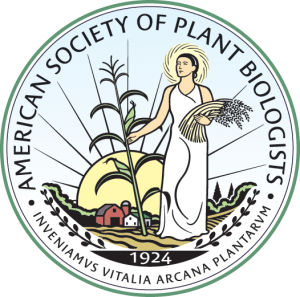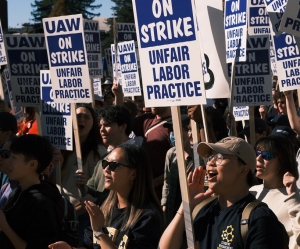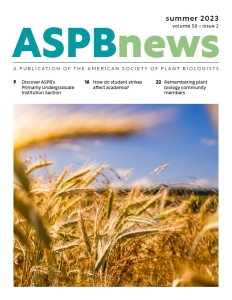ASPB News
Summer 2023, volume 50, issue 2
In Every Issue
President’s Letter
Come Together
BY Gustavo MacIntosh
Kansas State University
 While finishing my doctorate in Buenos Aires, I had one of many conversations with my PhD advisor regarding my future. I told her that I was planning to apply for postdoctoral positions outside of Argentina, and that my main targets were labs in the United States. Her answer still echoes in my head: “You will not be successful in the US environment.” At the time I was mad and did not ask her to elaborate; rather, my response was something along the lines of, “Watch me!”
While finishing my doctorate in Buenos Aires, I had one of many conversations with my PhD advisor regarding my future. I told her that I was planning to apply for postdoctoral positions outside of Argentina, and that my main targets were labs in the United States. Her answer still echoes in my head: “You will not be successful in the US environment.” At the time I was mad and did not ask her to elaborate; rather, my response was something along the lines of, “Watch me!”
Later in life, I have reflected many times on that particular conversation, and I think I get it now. She had been trained as a postdoc in the US in the biomedical field—in perhaps one of the most competitive areas of biochemistry at the time—and her perspective was that I would not thrive in the ultra-individualistic culture she had experienced. Fortunately, I didn’t have to.
I was lucky to land at the Michigan State University (MSU) US Department of Energy (DOE) Plant Research Laboratory, a place that had a welcoming and collaborative atmosphere. During my time there I established relationships that remain strong today, and I met some of the collaborators for my current main research projects. That experience set me up for a career focused on collaborative efforts that helped me succeed and, more importantly, enjoy my journey.
Indeed, a collaborative environment was one of the defining characteristics in choosing Iowa State University when I got my assistant professor position and, luckily, I was right about that, too.
It’s not only me, though. Plant biology seems more collaborative and cordial than other areas of research; however, there are also many plant biologists who focus on individual efforts. Based on the literature and people’s preferences, it is clear that there are advantages and supporters for both collaboration and individualism. In favor of individual approaches, some studies have observed no benefits in the fractional count of publications (the number of publications divided by the number of authors) in collaborations versus individual efforts. Individual work avoids the “free-rider effect” of collaborative groups and the extra time needed for group management and coordination. Researchers who work only in their individual laboratory group also like the sense of control.
Conversely, several studies have found benefits of collaborations. For example, collaborations increase overall publication productivity and grants activity, and collaborative teams tend to produce papers that are cited more frequently. In addition, as individual researchers are more specialized, collaborative research allows for participation in broader scientific questions. Groups that are diverse also benefit from different lived experiences and alternative viewpoints, further increasing creativity. It has also been proposed that just participating in collaborations changes the way individual scientists approach research. Most of the research on collaboration has focused on learning and research outcomes, but I expect that collaborative teams have a significant impact on mentoring and community- building, as well. Thus, it is evident that collaborations benefit individuals as well as the broader scientific community.
I bring up this topic not only because it is important to me but also because a recent survey reported that that members of professional societies from around the world identified collaboration as an area of interest. The survey observed a “clamor for increased collaboration,” reflected in the strong support for the idea that societies should promote greater collaboration among members conducting research. Professional societies are an ideal medium to foster collaborations, create the networks necessary to identify collaborators, increase visibility of researchers working in different geographic locations and types of institutions, and promote guidelines for data sharing and accessibility. Recommendations following the survey included a call for societies to work with each other. This is something that ASPB is already doing with diversity and inclusion through the Changing Cultures and Climates collaboration and the NSF-funded ROOT & SHOOT research coordination network. We have also embarked on agreements or are providing support to plant science societies in the Middle East, India, and Latin-America. It would be interesting to explore shifting the way professional society memberships function, perhaps allowing for multi-society memberships or implementing other ways to ensure that we can work together more fluidly.
The occurrence of collaborative teams has increased sharply in recent decades, and this modality has been promoted by federal agencies and academic institutions through funding opportunities for “big teams.” However, there is still a significant hurdle: Even proponents of increasing collaboration efforts struggle with credit allocation. How do we recognize individuals for their collaborative work? Or, as sociologist Erin Leahy wrote in her excellent review on the topic: “Arguably the biggest problem collaborations must solve in order to succeed is to find ways to divide the credit.” This is very important because our promotion systems still focus almost exclusively on individual achievements and celebrate individual accomplishments with awards, even as we promote teamwork. I find this concept highly problematic.
One of the biggest impacts on collaboration and teamwork is not an increase in production, it is the generation of new ideas that result from different perspectives—a “gestalt effect,” whereby no individual would generate a new, transformative direction of the research unless they interact with other members of a team. And this cannot be credited to individuals on the team. So, rather than thinking that collaborations are useful and then trying to fit them into an individualistic system, we must change the way we look at scientific progress and the systems we use to promote and recognize individuals. And this approach should extrapolate to other areas in our careers, such as leadership efforts and mentorship, as we attempt to move to distributive leadership and shared mentoring. This is also very important for equity and inclusion, because members of marginalized groups are frequently asked to participate and lead collaborative work, are responsible for most of the emotional effort, and are eventually tokenized when credit is distributed using traditional criteria.
“But,” you could say, “system change is hard and slow, and I cannot do it by myself.” Those in administration positions (Chairs, Deans, Provosts) can directly influence institutions to change the rubrics used for quantifying success. What can the rest of us do? We can actually have a big impact, particularly when using our influence. For example, while writing letters of recommendation, tenure evaluations, award nominations, we can put more value on collaborative activities and stop asking for details of individual contributions. Similarly, while evaluating student progress as part of PhD committees, we should recognize the effort put toward advancing collaborative projects even if they are not the “main” objective of the student’s thesis. In addition, members of committees should re-evaluate the criteria and type of awards given by institutions and professional societies (including ASPB). For those starting their career and considering collaborations, ask your institutional leadership (or boss, major professor, or any person further up the ladder with responsibility for assessing performance) how those efforts will be evaluated. Hopefully, the ensuing discussion will spark a change in approach.
Perhaps the most important project in need of collaborative efforts is system change. Even if each one of us does not have a clear idea of what a new system would look like, a collective idea will allow us to reconfigure the way we operate. As always, let me know what you think so we can work together.
_______________
We’re Listening!
Share your feedback on the Society and ideas to help ASPB better meet members’ needs.
Policy Update
Policy Update
BY JOANNA RATIGAN
Lewis-Burke Associates, LLC
Congressional Updates
FY2023 Appropriations Enacted with Increased Support for Environmental Research
In December 2022, President Biden signed into law a $1.7 trillion fiscal year (FY) 2023 appropriations package that increases funding to most federal programs of interest to the research and education communities. The bill includes many provisions favorable to climate and environment research, with funding increases to key programs at the NSF, DOE, and the USDA. Federal agencies will be now focused on spending FY2023 appropriations and issuing funding solicitations, as well as continuing to execute programs and release funding from the Bipartisan Infrastructure Law, the Inflation Reduction Act,
and microelectronics-focused activities from the CHIPS and Science Act. Highlights from the FY2023 omnibus package relevant to plant biology are provided below.
- Department of Energy: DOE received $46.2 billion, a 3.1% increase over the FY2022 enacted levels but below the President’s budget request and House and Senate marks of between $48 billion or $49 billion. The allocation includes $909 million for Biological and Environmental Research (BER), a 12.2% increase. That increase would partially fund DOE’s proposed Energy Earthshot Research Centers (EERCs), which will fund single- investigator and small group awards working towards DOE’s six existing Earthshots.
- National Science Foundation: NSF was funded at $9.9 billion in the omnibus when all supplemental funding is included, an increase of $1 billion or 11.7% above the FY2022 enacted level, the largest increase for the agency in over a decade. All growth to NSF would be provided by supplemental funding included in the omnibus bill, with $700 million in general funding for the agency and $335 million specifically included for implementing the science provisions of the CHIPS and Science Act, including the new Technology, Innovation, and Partnerships Directorate for which sustainability, climate, and the bioeconomy have been prioritized. The bill directs NSF to spend no less than $970 million to support Climate Science and Sustainability Research through the U.S. Global Change Research Program and Clean Energy Technology priority areas. This represents a 7.8% increase over FY2022 enacted levels.
- S. Department of Agriculture: The bill provides $1.7 billion for the National Institute of Food and Agriculture (NIFA), USDA’s premier extramural research agency, representing a modest 3.9 % increase. NIFA’s Agriculture and Food Research Initiative, USDA’s flagship competitive grants program, was funded at $455 million, a $10 million increase over FY2022 levels. Of note, the bill supports $1 million for the Agriculture Advanced Research and Development Authority (AGARDA) to develop a management structure and begin hiring staff. It also includes $2.5 million for the Agricultural Genome to Phenome Initiative, which is a $500,000 increase above the FY2022 enacted level.
Midterm Elections Bring Changes for Congressional Committees and Climate and Environment Legislation
Following the midterm elections, Democrats retained control of the Senate and Republicans won a narrow majority in the House. This will usher in an era of divided government. It is unlikely that there will
be passage of highly partisan legislation nor successful attempts to roll back major legislative packages passed during the 117th Congress, including the Inflation Reduction Act which contained substantial energy- and climate-related provisions. The 118th Congress also faces some of the most significant leadership changes in over 20 years, with at least 15 new Chairs or Ranking Members impacting 14 different House and Senate Committees. Under a Republican majority, the House is likely to prioritize oversight of federal agencies and implementation of recent landmark legislation and will face difficulty advancing climate-focused legislation.
Senate Agriculture Committee Holds Hearing on Farm Bill Research Title
In early December 2022, the Senate Agriculture Committee held a hearing to discuss the Farm Bill Title VII, Research and Related Matters, in preparation for the upcoming Farm Bill reauthorization. The hearing featured Dr. Chavonda Jacobs-Young, Under Secretary for Research, Education, and Economics at the USDA, as the sole witness on the first panel.
Under Secretary Jacobs-Young advocated for three areas that would help strengthen agriculture research: investing in research, bolstering agricultural infrastructure, and promoting agricultural workforce development.
Under Secretary Jacobs-Young stated that USDA will be publishing an implementation plan for the AGARDA, which was authorized in the 2018 Farm Bill, in early 2023. Due to a lack of long-term committed resources, she also conceded that there is currently no timeline to hire an Executive Director for AGARDA. In the meantime, she said USDA is collaborating with the Foundation for Food & Agriculture Research to help facilitate stakeholder engagement regarding the structure and operations of AGARDA. Witnesses on the second panel additionally emphasized the need for increased investments in agriculture research infrastructure, workforce development and diversity, and fundamental research to address societal challenges impacting agriculture. The Senate Agriculture Committee will continue to hold Farm Bill hearings throughout the next several months. The current Farm Bill expires in September 2023 and will require Congress to pass a new bill or extend the current legislation.
Congressional Committees Determine New Leadership for the 118th Congress
The House and Senate have begun announcing Committee assignments for the new Congress, and several committees that oversee priority topics for ESA will see changes, most notably in the House following its shift to a Republican majority. Representative Bruce Westerman (R-AR) will now lead the House Natural Resources Committee, and he will likely prioritize energy permitting, pushing back on the Biden Administration’s policy on fossil fuels, and forestry issues. Former Ranking Member of the House Agriculture Committee, G.T. Thompson (R-PA) will now serve as Committee Chair and will oversee the Farm Bill reauthorization this year.
The House Appropriations Subcommittees also saw significant changes to their leadership, with new Chairs for the Agriculture, Energy- Water, and Commerce-Justice-Science Subcommittees in Representatives Andy Harris (R-MD), Chuck Fleischmann (R-TN), and Hal Rogers (R-KY) respectively. These Subcommittees control funding for key research agencies, including the U.S. Department of Agriculture, Department of Energy (DOE) and the National Science Foundation (NSF). Now that committee makeup is largely determined, both chambers are expected to start tackling emerging legislative priorities including fiscal year (FY) 2024 appropriations and the Farm Bill.
Agency and Administration Updates
OSTP Continues Efforts to Advance the Bioeconomy
As part of the Biden Administration’s ongoing work to advance research and development related to the bioeconomy, the White House Office of Science and Technology Policy (OSTP) released a new report prepared by the President’s Council of Advisors on Science and Technology (PCAST). The PCAST report presents several recommendations for how biomanufacturing should be harnessed to effectively address, among other topics, the nation’s goals related to sustainability, environmental justice, and climate change.
The report was required by President Biden’s September 2022 Executive Order, Advancing Biotechnology and Biomanufacturing Innovation for a Sustainable, Safe, and Secure American Bioeconomy.
USGCRP Releases 2022-2031 Strategic Plan
The U.S. Global Change Research Program (USGCRP) released their 2022-2031 Strategic Plan to outline their shared priorities, which reflect input from all 13 participating agencies. The strategic priorities are organized in four pillars: advancing science, engaging the nation, informing decisions, and collaborating internationally. In contrast to prior decadal studies, this one is notable in its increased emphasis on diversity, equity, and inclusion, and its explicit discussion of the importance of the inclusion of indigenous knowledge. Further, the strategy also places a greater emphasis on of the relationship between climate change and other global challenges, including biodiversity loss, which is an increasing focus of USGCRP under the leadership of its Director Mike Kuperberg and the OSTP Deputy Director for Climate and
Environment Jane Lubchenco. The strategy was published as USGCRP is conducting work on two major products: the Fifth National Climate Assessment, and the first National Nature Assessment, with input welcome through March 31, 2023.
OSTP Holds Community Forum Regarding Public Access Policy Guidance
Officials from the OSTP discussed their recent policy memorandum to federal agencies concerning their public access policies in a forum held on November 7, 2022. The policy memo, as an update to the previous guidance issued in 2013, requires all publicly funded research, including both publications and the underlaying data on which they are based, to be made publicly available by 2025. During the forum, OSTP Deputy Director for Science and Society Alondra Nelson emphasized that agencies have been given discretion to determine if the scope of their implementation will extend beyond peer-reviewed journal articles to also include peer reviewed book chapters, monographs, or conference proceedings. In addition, agencies will also have discretion to develop innovative ways to track and share data and publications throughout the research cycle, which could include augmenting or building on capabilities of existing data repositories.
Speakers from the National Aeronautics and Space Administration, National Institutes of Health, and Institute of Museum and Library Services shared their progress to date on responding to the 2022 Public Access Memo. Each agency will take a different approach, though all emphasized that they anticipate opportunities to engage with the community to inform their response.
Nations Agree to New Framework to Slow Biodiversity Loss
In a historic agreement, 196 nations approved a new global biodiversity framework that established new targets to curb biodiversity loss in an agreement known as the Kunming- Montreal Global Biodiversity Framework. The agreement sets out that parties to the United Nations Convention on Biological Diversity (CBD) will establish domestic goals to help achieve the conservation of 30% of the world’s land, inland waterways, and coastal and ocean areas by 2030, referred to as the 30 by 30 goal. Like the Paris Agreement on Climate Change, this new agreement leaves it to each country to establish their own pathways to achieve results, with work towards 23 targets, including goals to reduce farm runoff, the rate at which invasive species are introduced to ecosystems, and the risk of pesticides. Although the United States is not party to the CBD, the agreement reached is consistent with the Biden Administration’s America the Beautiful Initiative, which includes its own 30 by 30 goals. CBD parties also took a decision to establish a new multilateral financial mechanism for the sharing of benefits from the use of digital sequence information (e.g., genetic sequence data), though the details of the fund are anticipated to be discussed further leading into the next CBD meeting, anticipated to take place in 2024 in Turkey. Conversations there will address how this fund will interface with academia and industry as it pertains both to research and technology development.
White House and Department of Commerce Release Strategy to Implement Natural Capital Accounting
The Office of Science and Technology Policy, Office of Management and Budget and the Department of Commerce announced the release of a new National Strategy to Develop Statistics for Environmental Economic Decisions. This document is intended to enable a national approach to capture the value of natural capital as a part of measuring economic progress to inform business and policy decision-making. Other countries, like China, have already begun to capture the value of natural capital as a part of their productivity as a part of “gross ecosystem product,” which is tracked along with other traditional growth metrics like gross domestic product. In addition to providing background information about what natural capital accounting is and how environmental statistics can be a valuable tool to help track the value of nature in long- term economic forecasts, the strategy includes guidelines to assist the U.S. government to operationalize recommendations. Of interest to the research community, the strategy reviews interdisciplinary data and research needs that may lead to a broader adoption of this strategy into the future, including topics in environmental and agricultural economics, statistics, biological sciences, and environmental sciences.
NSF ERE Releases Report on Engaged Research in Environmental Disciplines
The National Science Foundation (NSF) Directorate for Environmental Research and Engineering (ERE) released a report on the principles of engaged research and its advantages to address societal challenges relevant to environmental research. The report encourages involvement of non-scientists with valuable alternative or traditional expertise in research to broaden participation, further innovation and basic discoveries, and produce knowledge that is relevant and useful to the impacted communities. The Advisory Committee for ERE, whose experiences informed the development of this report, propose that NSF increase their support for engaged research, particularly to address grand challenges of science, engineering, and sustainability, while supporting underserved communities and promoting social justice. The report cites future opportunities in engaged research, including climate change adaptation, energy transitions, the food-energy-water nexus, and urban systems.
COP27 Climate Conference Negotiated Outcome Makes Progress on Addressing Climate Impacts
President Biden, the U.S. climFNIHate negotiations team led by Special Presidential Envoy on Climate Change John Kerry, and several Cabinet officials represented the U.S. at the United Nations Framework Convention on Climate Change (UNFCCC) Negotiations in Sharm el-Sheikh, Egypt from November 6–19, 2022, referred to as COP27. At this meeting, U.S. officials highlighted success linked to congressional support for ambitious progress to address climate change such as the Inflation Reduction Act and the Infrastructure Investment and Jobs Act, both of which passed after last year’s climate conference (COP26). In addition, the U.S. joined many international partners to announce new programs and updates to existing programs, including a few with direct linkages to international research. Ultimately, the negotiated outcome was unique in its focus on addressing existing climate change impacts, rather than advancing ambition on climate change mitigation. At COP27, UNFCCC parties agreed to establish a fund to address the loss and damage that developing countries are already facing because of climate change. Although the United States and other developed countries have pushed back against this agenda in the past, it represents an international approach of the Biden Administration’s environmental justice agenda and provides an even stronger demand signal for research in innovative insurance mechanisms to help reduce risks to vulnerable communities. The final agreement also expanded attention under the UNFCCC to promote agriculture and food security, with the approval of a new four-year work program that will support for agricultural data sharing, as well as collaboration and exchange to address climate smart agriculture and nature- based solutions.
2022 National Security Strategy Identifies Climate Change as a Major Theme
The Biden Administration’s 2022 National Security Strategy, a document sent from the President to Congress to communicate the executive branch’s national security vision, puts climate change as a central issue to U.S. engagement in foreign affairs and international policy including with respect to China and the Arctic. The Strategy identifies climate change as a major theme, indicating that it is “the existential challenge of our time,” as it notes that the impacts of climate change threaten food and water supplies, infrastructure, health, and national security in general. To protect U.S. interests, the strategy calls for climate considerations to be incorporated into national security and financial policies and planning. Further, in addition to enhancing federal, state, and local preparedness, the strategy calls for more ambitious climate agreements and international research collaborations.
White House Releases Global Food Security Research Strategy
The Biden Administration released the U.S. Global Food Security Research Strategy for fiscal year (FY) 2022-2026, intended to support the U.S. Government Global Food Security Strategy 2022-2026 (GFSS) released in Fall 2021. The GFSS and accompanying research strategy highlight three core objectives: “(1) inclusive and sustainable, agriculture-led economic growth; (2) strengthened resilience among people, communities, countries, and systems; and (3) a well-nourished population, especially among women and children.” The Research Strategy emphasizes the importance of agricultural research to economic growth, climate change adaptation and mitigation, inclusive development, and nutritional health. It also highlights the role of partnerships with U.S. universities, including Minority-Serving Institutions and those affiliated with Feed the Future Innovation Labs. The strategy expresses that convergence research, building diverse research teams, interdisciplinary research, scaling and translation of innovations, and community engagement are essential to achieve the goals of the GFSS. The Research Strategy additionally indicates that Feed the Future will support research across three themes: (1) climate-smart agricultural innovation, (2) nutrition and food systems, and (3) genetic improvement of crops and livestock. Federal commitments to global food security research will continue to prioritize convergent, inclusive research that incorporates the biophysical, socioeconomic, and behavioral sciences.
Funding and Engagement Opportunities
OSTP Issues RFI to Inform National Nature Assessment
The White House Office of Science and Technology Policy (OSTP), on behalf of the USGCRP, issued a request for information (RFI) to inform the development of the first National Nature Assessment (NNA). President Biden called for this initiative as part of Executive Order 14072, Strengthening the Nation’s Forests, Communities, and Local Economies, issued on Earth Day this year. The NNA will “assess the status, observed trends, and future projections of America’s lands, waters, wildlife, biodiversity, and ecosystems and the benefits they provide, including connections to the economy, public health, equity, climate mitigation and adaptation, and national security.” USGCRP will offer several more opportunities for public engagement throughout the process of developing the NNA.
NSF and USDA Release Dear Colleague Letter to Jointly Fund CIVIC Proposals
The NSF and the USDA NIFA released a Dear Colleague Letter (DCL) announcing their intention to jointly fund Stage 2 proposals of the Civic Innovation Challenge (CIVIC). Proposals should address food and agricultural challenges facing local communities through either CIVIC Track A, which is focused on adaptation, mitigation, and resilience, or Track B, which is focused on improving access to essential resources and services. NSF and NIFA particularly encourage proposals involving partnership with rural communities, as well as proposals concerning urban, indoor, and emerging agriculture. Only teams with active CIVIC Stage 1 awards are eligible to submit proposals to this DCL.
NIEHS Solicited Input on 2024-2028 Strategic Plan
The National Institute of Environmental Health Sciences (NIEHS) has released a request for information (RFI) to inform the development of the NIEHS 2024–2028 Strategic Plan. Comments can broadly pertain to the discipline of environmental health sciences or to the three themes in the current Strategic Plan: (1) Goals for Advancing Environmental Health Sciences (EHS); (2) Goals for Promoting Translation; or (3) Goals for Enhancing EHS through stewardship and support. Responses were due by April 30, 2023.
USDA Seeking Nominations for NAREEE Advisory Board
The U.S. Department of Agriculture (USDA) released a call for nominations to the National Agricultural Research, Extension, Education, and Economics (NAREEE) Advisory Board at large, as well as its Citrus Disease Subcommittee, National Genetic Resource Advisory Council, Specialty Crop Committee, and Pollinator Subcommittee. The NAREEE Advisory Board advises the USDA Secretary and land-grant universities on priorities in food and agriculture to ensure impactful federal agriculture research and education programming. Nominations are no longer being accepted, but applications will be accepted continuously until December 29, 2023.
Member News
Member Spotlight: An Interview with Sterling Field
Member Spotlight: An Interview with Sterling Field
 Postdoctoral Fellow
Postdoctoral Fellow
Department of Plant Biology, Carnegie Institution for Science, Stanford, CA
Research Area: Plant cellular and molecular biology, biomolecular condensates
Member Since: 2013
How/why did you get into plant science?
I’ve been a plant geek for as long as I can remember. I first got into plant science because I enjoyed gardening and growing plants as a child. In middle school I started getting more interested in horticulture, and in high school I became fascinated with how plants develop and function. In college, I eagerly sought out classes on plant biology, which further exposed me to the complexity and diversity of plants.
I was eager to learn more about plants outside of the classroom, and worked in the Biological Science teaching greenhouses at Ohio State for a year, and then joined a molecular genetics lab researching Arabidopsis floral development. These experiences ultimately cemented my love for plants and the molecular mechanisms that underpin their fascinating forms and behaviors.
What is your favorite thing about being a plant biologist?
My favorite thing about being a plant biologist is getting to work with amazing and caring people. I first entered the plant biology world out of fascination for plants, but it is the people who make up our community that have made plant biology feel like home. I have worked with scientists from across fields and I always notice that the folks in plant biology are usually very nurturing to their mentees. Additionally a lot of the folks I interact with have a goal of making the field more diverse and to celebrate this diversity.
How do you gather scientific information? What are your sources?
This depends on the type of scientific information. In the lab, much of my research is centered around microscopy. When I am searching scientific literature, I will frequently search topics to first find review articles and then try to identify key words and follow up primary research articles from there. If I am trying to identify a new technique or plant phenotype, I frequently use Google image search and will then follow up with the primary research article the images are from. I have also been surprised at the amount of information I receive from more passive activities, like scrolling Twitter or attending a random and distantly related seminar. These are great ways to be exposed to new areas I would not have thought to look for connections to my research. Overall, I try to find peer-reviewed articles, or articles from reputable sources.
A lot of information that can be used to improve our communities doesn’t come from sources classically defined as “scientific” or “peer reviewed.” This doesn’t necessarily make these sources less valid. A solid peer-reviewed survey published with statistics is superb, but the information required to make a change
in our society is not always peer-reviewed. Experiential information matters; the written and spoken experiences of folks in our society are valid documentation of issues. Data gathered by non-profit organizations, which are published, are not always found in a peer-reviewed journal. When writing on ways to improve our community, whether this is dealing with food scarcity or experiences of marginalized folks in STEM, relevant articles and first-hand stories are just as powerful as data and statistics. The responsibility falls on the writer to weigh the source appropriately and ensure its veracity.
How important is social media to your education or career as a plant scientist? In what ways?
Social media has been incredibly useful in exposing me to new and diverse topics in science. I lead the LGBTQ+ Plant Scientist network (@LGBTQPlantSci) and we frequently share resources for early career and LGBTQ+ scientists, as well as funding opportunities, and seminars/conferences. I use Twitter a lot personally (@Sterling_Field) as well and I frequently find out about meetings, conferences, new articles, and techniques outside my immediate bubble by just scrolling. Whether we like it or not, Twitter has turned into a platform for sharing our science with other scientists and the general public. I think it needs to be treated as a tool that can help us get our message out and be used to educate the public about science.
What do you think is the next “big thing” in plant biology? Why?
The next big thing in plant biology will be understanding how biomolecular condensates and phase separation impact plants. Biomolecular condensates are membraneless cellular compartments that can form and dissolve rapidly, and are composed of proteins and usually nucleic acids. Human and yeast systems have identified biomolecular condensates being involved in a ton of different processes, including metabolism, regulating the cell cycle, the circadian clock, development, and transcription and translation. Interestingly, numerous human neurological pathologies have also implicated malfunctioning biomolecular condensates, as well as human viruses like polio, hepatitis, and even Covid manipulate condensates during infection of cells. I am very excited to see how condensates in plants are different from these other systems, how they impact plant cellular function, and how we can use and manipulate these condensates to engineer better and more stress-resistant plants.
What do you see as the most important role for scientific societies such as ASPB?
I think the most essential role for scientific societies is to act as shepherds for their field. This is achieved when the organization becomes greater than the sum of its parts, through generating and fostering community growth. This is accomplished through development of its members at multiple career levels, identifying ways community members can bring their expertise to benefit others, serving the needs of the community (which includes lobbying the government for sane policies for research and for funding), and helping to engage the public to bring science out of the lab and classroom and into more peoples lives. I think ASPB is doing a good job of engaging early career scientists through initiatives like the Early Career Plant Scientists (ECPS) section, as well as building community through online events, seminars, and in-person conferences. I think there is always room for ASPB to further grow and meet the needs of its diverse membership by taking on more grassroots and membership- driven initiatives. I would like to encourage folks to get more involved with ASPB and join discussions on how we can make sure ASPB meets the needs of our community going into the future.
What are you reading these days?
I can quickly lose myself in a good sci-fi novel. Recently I have not been reading as much as I used to, but when I get the chance my favorite novels are Ecotopia by William Weston, Parable of the Sower by Octavia E. Butler, and The Dispossessed by Ursula K. Le Guin.
What would you tell colleagues to encourage them to join ASPB?
Science is a community-focused discipline, everything in our field requires us to interact, communicate, and share with other people. One of the best ways to develop and participate in this community is through professional societies like ASPB. The plant biology community is particularly lucky to have ASPB because of their commitment toward elevating folks at all career levels, enthusiasm for member- and grassroots- driven initiatives, and work to foster and shepherd our community for future scientists. ASPB also has numerous initiatives that bridge the gap between the public and the scientific world, enabling scientists and educators to reach a broader audience and impact our larger communities.
Was someone instrumental in getting you to join ASPB?
All my mentors encouraged me to be involved with ASPB, but the reason I first joined ASPB was my senior thesis advisor at The Ohio State University, Rebecca Lamb, PhD. Rebecca was a great mentor and helped me attend my first ASPB meeting (the ASPB-Midwest meeting in 2013) where I presented my thesis research. I really enjoyed this experience because all the participants at the meeting were friendly plant biologists from across the Midwest and made the meeting feel like a welcoming and educating community. I joined ASPB shortly after this meeting and have stayed active ever since.
Have you enhanced your career, lab, research, or education using ASPB, the Plant Biology meeting, section meetings, Plantae.org, The Plant Cell, Plant Physiology, or Plant Direct? If so, please describe which services were most helpful and how so.
Being part of ASPB has benefited my scientific career, as well as my personal development. I served as a Conviron Scholar, a Plantae Fellow, and an ECPS-DEI committee member. I have remained active within ASPB by maintaining the LGBTQ+ Plant Scientist Network, hosting events at the international Plant Biology conference, and by organizing a blog series on Plantae. The Conviron Scholars and Plantae Fellow programs have helped me improve my writing, speaking, and interpersonal skills, and helped open my eyes to the diversity of our community and the different career paths available to me as a plant scientist. Last but not least, participating in ASPB has brought me new friends and a sense of belonging within the plant science community. This support was particularly helpful during my time in schools with small plant science communities and still benefits me today as ASPB connects me to amazing scientists and educators across the world.
Member Spotlight: An Interview with Dr. Thelma Madzima
Member Spotlight: An Interview with Dr. Thelma Madzima
 Associate Professor
Associate Professor
School of Science, Technology, Engineering & Mathematics
The University of Washington Bothell
Research Area: Epigenetic regulation of environmental stress in plants
Dr. Thelma Madzima was promoted to Associate Professor at the Washington University at Bothell,
a primarily undergraduate institution (PUI). Besides teaching undergraduates, her research covers epigenetics of stress response in Zea mays. She has also worked on the model plant Arabidopsis thaliana and is interested in other agricultural plants.
Before coming to the United States, she undertook her early studies up to high school education in Zimbabwe. In the United States, she completed her undergraduate studies in plant sciences at Fort Valley State University, and a graduate degree in plant molecular and cellular biology from the University of Florida in 2009 in the lab of Dr. Kevin Folta. She then undertook her Postdoctoral research in the lab of Dr. Karen McGinnis at the Florida State University before joining the University of Washington Bothell faculty.
Dr. Madzima is an avid supporter of Diversity, Equity, and Inclusion (DEI) in science through active participation in advocacy for better representation and retention of scientists from marginalized communities in scientific societies and organizations. She previously served (2017- 2020) on the ASPB Minority Affairs Committee (MAC) (now Equity, Diversity and Inclusion (EDI) Committee). She is currently an active member of the Maize Genetics Cooperation’s Committee on Outreach, Diversity, Inclusion, and Education, tasked with addressing DEI matters in the more extensive maize genetics cooperative committee. She received the 2022 ASPB Excellence in Diversity and Inclusion Award and the 2022 ASPB Excellence in Education Award. She also received the 2022 Maize Genetics Cooperation Leadership Award for contributing to mentorship, leadership, outreach and education.
What interested you in plant biology in general, and what influences directed you to your specific area of research?
My upbringing, in general, got me interested in plant biology. I was born and raised in the southern African country of Zimbabwe, and as an indigenous African, our relationship with land, plants, and agriculture is strong and inherent. But I wasn’t exposed to molecular biology research of plants until I was an undergraduate student studying at Fort Valley State University, an HBCU (in the U.S.). There, I met my long-term mentor and friend, Dr. Sarwan Dhir, who introduced me to “plant biotechnology.” As an undergraduate, I was exposed to and intrigued by the idea that we can manipulate plants genetically or even their environment to enhance desired traits. The potential applications of this to agriculture was exciting to me.
What was the most difficult stage of your career?
Graduate school was the most difficult stage of my career. For many different reasons, graduate school is generally difficult for most people. It was an interesting and unique stage of my life. However, at the age of 21, that was my first experience as the “first and only.” All my life until then, I had been part of the majority racial group in Zimbabwe and then attending an HBCU for my undergraduate degree.
In addition to my studies, I was navigating the isolation of being the only Black student in my program (for a while) and dealing with what I now know to be microaggressions. I didn’t know the word “microaggression” at the time, although knowing the word doesn’t make the experience on the receiving end any better. However, participating in the Black student and international communities brought a sense of belonging to me.
What keeps you inspired in your work and research?
In my role as an educator, the students are my inspiration. I work at a PUI and being able
to work and interact with students at such an exciting and impressionable stage of their
academic and professional careers brings me joy.
In my research, I am personally motivated by my desire to address the issues relating to the impact of environmental stress on crop productivity. This is coupled with my passion for understanding the intrinsic molecular processes that occur in the cell. Combining my interests keeps the work interesting to me.
What would you do with your time if you had six months off?
Coincidently, I am fortunate to have recently taken one year off for sabbatical leave and have asked myself this question a lot lately. I see it as a time to redefine my ideal academic life. My goal is to curate my academic activities to be aligned with my values and goals, something I learned through coaching from WellAcademic.
During the time off, I was engaging intellectually with farmers, breeders and plant molecular biologists on the African continent, writing (blog posts, papers and grants), and reigniting my passion for art in various forms (drawing and photography).
You’ve been in the news recently for your efforts to increase equity in plant biology. Would you like to comment on that or suggest ways that others could act to improve equity?
Speaking up as a junior faculty member can be risky for one’s career. I speak up because there are not enough Black and Indigenous faculty of senior rank to speak up on our behalf. I want to ensure that the academic culture and environment are more welcoming to upcoming scientists of marginalized identities. I never want the next generation of scientists to have to overcome the challenges and obstacles that I and others have faced because of our identities.
My general advice on this issue is that in policymaking, we should always base our decisions on the view of the most marginalized within our communities to create a truly inclusive environment. The current culture is that policies are made to cater to well/over-represented individuals in our environment, often to appease those members and to avoid pushback and their discomfort. I would also remind people that real change happens outside our comfort zone.
As an employer, what are the key qualities you look for in a potential team member?
Apart from the training and the scientific skills the candidate brings in, I highly value interpersonal skills. For example, I think the scientific skills have already been well evaluated for well-trained individuals such
as a postdoc. I am people centered; the people are the ones doing the science and creating an environment that is welcoming and supportive is key. I am interested in how well you work with people from diverse backgrounds. People perform their best in environments that are safe, welcoming and respectful of their identities and backgrounds.
What advice would you give to a student interested in plant biology today?
As they navigate through their studies, I would encourage them to participate in mentorship programs, including those outside of their graduate program; I believe that finding support through mentorship will help students navigate the system to guide them through the process.
What advice would you give educators to encourage young people to explore science and plant biology?
From the general biology perspective, students in such programs should be exposed to plant science research and advances, using more examples in the classroom and lectures. There is also a need to promote more plant scientists by inviting them to participate in general biology seminars and programs at high schools and colleges.
We also need to put more effort into addressing historical issues that are associated with land and people from marginalized communities; such actions can be seen in land acknowledgements, but much more should be done to bring out the key historical roles of such communities as custodians of our plants and in crop and food production to emphasize the importance of plants and agriculture to human life and society.
Discover ASPB’s Primarily Undergraduate Institution Section
Discover ASPB’s Primarily Undergraduate Institution Section
Primarily Undergraduate Institution (PUI) is a section of ASPB dedicated to expanding PUI-associated activities and resources and creating a community of PUI-affiliated faculty, undergraduate students, graduate students, post-docs and more. The goal is to establish a community of PUI-affiliated members that encourages conversation and access to insight and resources. Those involved may be employed by, considering a career in, or affiliated with research or education at a PUI institution. This section establishes wide-ranging connections for year-round support.
So, why get involved with a PUI and join ASPB’s PUI Section?
Some PUI Section members share their thoughts here.
 “I am a first-generation college student in my family. I chose to be in a PUI simply because as a scientist I keep learning with my students. I enjoy seeing the joy in my students when they understand a concept we discuss in class or learn how to use a pipette in the lab. Also, PUI’s are very dynamic and provide me with freedom to do the kind of research I want. I have found that every day is different and deeply rewarding, and as you meet the challenge of accomplishing the targets you set each semester, you never get bored.”
“I am a first-generation college student in my family. I chose to be in a PUI simply because as a scientist I keep learning with my students. I enjoy seeing the joy in my students when they understand a concept we discuss in class or learn how to use a pipette in the lab. Also, PUI’s are very dynamic and provide me with freedom to do the kind of research I want. I have found that every day is different and deeply rewarding, and as you meet the challenge of accomplishing the targets you set each semester, you never get bored.”
CHRISTOS NOUSTOS • SUNY Old Westbury in Long Island, NY
 “Working at a PUI, I get to know all my students, and some of my students very well, because I see them in class, in lab, in research, in the hallways, for advising, etc. The focus at PUIs is typically on the students and less on your performance as a biologist. I also love working in a small department where teaching is our focus, so rather than have plant conversations in the hallway, we have conversations about teaching best practices, or how to build in DEI in your classes and exams. Plus, I enjoy the work/family balance!”
“Working at a PUI, I get to know all my students, and some of my students very well, because I see them in class, in lab, in research, in the hallways, for advising, etc. The focus at PUIs is typically on the students and less on your performance as a biologist. I also love working in a small department where teaching is our focus, so rather than have plant conversations in the hallway, we have conversations about teaching best practices, or how to build in DEI in your classes and exams. Plus, I enjoy the work/family balance!”
SUSAN BUSH TRIPP • Metropolitan State University in St. Paul, MN; 3 years
 “The most challenging thing about working at a PUI is the lack of time to focus on research because of heavy teaching load. However, there are many opportunities to write grants such as the National Science Foundation-Research in Undergraduate Institutions (NSF- RUI) grant and Research Reassigned Time grant from your university to request for teaching release time to focus on research. Furthermore, the NSF grant will allow you to hire a post-doctoral fellow. The other challenge is lack of faculty colleagues with similar research interests which can lead to research loneliness. The ASPB-PUI section members have been very helpful all along my faculty career.”
“The most challenging thing about working at a PUI is the lack of time to focus on research because of heavy teaching load. However, there are many opportunities to write grants such as the National Science Foundation-Research in Undergraduate Institutions (NSF- RUI) grant and Research Reassigned Time grant from your university to request for teaching release time to focus on research. Furthermore, the NSF grant will allow you to hire a post-doctoral fellow. The other challenge is lack of faculty colleagues with similar research interests which can lead to research loneliness. The ASPB-PUI section members have been very helpful all along my faculty career.”
VIJAYKUMAR VEERAPPAN • Eastern Connecticut State University; 7 years
 “Prior to Spelman College, I worked at the University of Arizona, first as a postdoc, then as a research scientist. During this time, I worked with some amazing undergrads in the lab, so I intentionally looked for positions at PUI when I was ready to move forward. I didn’t have a lot of teaching experience before landing my current job. Spelman saw my potential and gave me a chance. I’ve learned that research can progress at a slower pace at a PUI, but I also have the freedom to pursue research directions that interest me without being overly concerned about the larger funding environment. For me, a position at PUI has the right mix of research, mentoring, and teaching responsibilities.”
“Prior to Spelman College, I worked at the University of Arizona, first as a postdoc, then as a research scientist. During this time, I worked with some amazing undergrads in the lab, so I intentionally looked for positions at PUI when I was ready to move forward. I didn’t have a lot of teaching experience before landing my current job. Spelman saw my potential and gave me a chance. I’ve learned that research can progress at a slower pace at a PUI, but I also have the freedom to pursue research directions that interest me without being overly concerned about the larger funding environment. For me, a position at PUI has the right mix of research, mentoring, and teaching responsibilities.”
DONGFANG WANG • Spelman College, Biology Department; 11 years
 “If you’re undecided in a career path, remember that it is normal to forget what it’s like to be an undergraduate if you spend a lot of time in a research-intensive environment. That is why I highly encourage working with undergraduates of all ages from diverse backgrounds and groups to help in deciding a career while refining your people and time management skills. Another activity that has always proven helpful is networking and/or attending events that provide support for prospective PUI faculties, like the virtual networking event sponsored by the PUI Section of American Society of Plant Biologists.”
“If you’re undecided in a career path, remember that it is normal to forget what it’s like to be an undergraduate if you spend a lot of time in a research-intensive environment. That is why I highly encourage working with undergraduates of all ages from diverse backgrounds and groups to help in deciding a career while refining your people and time management skills. Another activity that has always proven helpful is networking and/or attending events that provide support for prospective PUI faculties, like the virtual networking event sponsored by the PUI Section of American Society of Plant Biologists.”
ANSUL LOKDARSHI • Valdosta State University; 2 years
 “I didn’t start my education journey necessarily intending to work in academics, much less a PUI specifically. That interest developed slowly through the years. PUI positions are not a “consolation prize” if you can’t get a job at an R1. We are just a different type of faculty position and require individuals who are just as dedicated and highly developed in their relevant skillsets as anyone at an R1. The most rewarding part of my job is seeing my students go on to exciting careers that will contribute to society.”
“I didn’t start my education journey necessarily intending to work in academics, much less a PUI specifically. That interest developed slowly through the years. PUI positions are not a “consolation prize” if you can’t get a job at an R1. We are just a different type of faculty position and require individuals who are just as dedicated and highly developed in their relevant skillsets as anyone at an R1. The most rewarding part of my job is seeing my students go on to exciting careers that will contribute to society.”
DEREK GINGERICH • University of Wisconsin-Eau Claire; 16 years
__________________
Learn more about ASPB’s PUI Section.
Community Updates
Community Updates
AWARDS & RECOGNITIONS
Olena Boika
Olena serves on the editorial boards of three international journals, as reviewer of five international journals, and is a member of 10 scientific and professional communities from all around the world.
PERSONAL CELEBRATIONS
Ilga Winicov
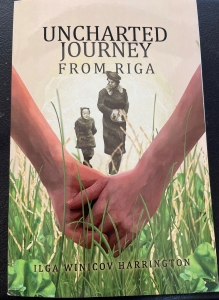 Ilga’s book, Uncharted Journey from Riga, was published by Dorrance Publishers earlier this year. It is the story of a Latvian immigrant woman working to survive WWII and post-war Germany as a displaced person and who goes on to become a scientist in academia in the U.S.
Ilga’s book, Uncharted Journey from Riga, was published by Dorrance Publishers earlier this year. It is the story of a Latvian immigrant woman working to survive WWII and post-war Germany as a displaced person and who goes on to become a scientist in academia in the U.S.
CAREER UPDATES & MILESTONES
Jeffrey Dean
After nearly nine years in Starkville, Jeffrey Dean left his position as head of the Department of Biochemistry, Molecular Biology, Entomology and Plant Pathology at Mississippi State University to take on the role of Assistant Provost and Director of the University of Georgia, Griffin campus effective January 1, 2023. For his academic appointment, Dr. Dean joined the Department of Plant Pathology in the College of Agriculture and Environmental Sciences.

Saroj Sah
Saroj Kumar Sah is a research associate at Brookhaven National Laboratory where he investigates the regulatory mechanisms controlling lipid metabolism, trafficking, and storage in plants. (photo by Russ Houston / © Mississippi State University)
 Christian Siadjeu
Christian Siadjeu
After Christian completed his master’s degree in plant biotechnology in Cameroon, he received a DAAD scholarship to complete his PhD in Germany at the University of Oldenburg. He is currently a postdoctoral researcher at the Ludwig Maximilian University of Munich in Germany, working on the evolution and regulation of C4 photosynthesis genes in succulent plant species. He uses multi-omics approaches involving comparative transcriptomics, metabolomics, proteomics, and genomics.
Jaspinder Singh
In December 2022, Jaspinder received his doctorate in plant breeding and genetics from the University of Nebraska-Lincoln, and as of January 2023 joined Bayer Crop Sciences as a crop scientist.
Features
What do the Effects of the UC Strike Mean for Academia?
For six weeks graduate students and postdocs in the University of California system were on strike.
What do the Effects of the UC Strike Mean for Academia?
BY MAX BARNHART
For several weeks last fall, research and teaching in the University of California (UC) system came to a screeching halt as graduate researchers, teaching assistants, and postdocs went on strike.
The strike, which began on November 14 and officially ended on December 23, resulted in new collective bargaining agreements being supported by the striking workers and the UC system.
For those reading this article who are not a part of the UC system, you probably heard about the strike, and have maybe even talked to your UC colleagues about it. But for those of you who might not be aware of exactly what happened or why, this high- level overview of key issues and events will help you understand the strike and its outcome, as well as the potential ripple effects on academia.
The Strike’s Origin
Bargaining began between the UC system and the United Auto Workers (UAW) union, which was representing academic workers in the Spring of 2021, meaning that everyone was preparing for a strike well in advance of it actually happening.
“It was really no secret that things were going to coalesce all into one big thing on November 14,” says ASPB member and fifth-year PhD candidate at the University of California Davis, Cody Bekkering, who was a participant in the strike.
During the course of the bargaining, UAW claims that the UC system engaged in upwards of 30 Unfair Labor Practices, which hindered the academic workers from bargaining fairly. This was the legal basis for the strike and the means by which the striking workers were protected by federal labor laws.
The strikers were made up of four bargaining units: academic researchers (mainly staff scientists), postdocs, teaching assistants, and student researchers united, a newly formed bargaining unit that represented students who were paid through research assistantships and those who were paid through fellowships like the NSF GRFP. Those four bargaining units set out to achieve four main goals, among other smaller goals: fair compensation, support for working parents, disability accommodations, and anti- bullying and harassment protections.
The focus on fair compensation centered around something called rent burden, which is when over 30% of a worker’s pay goes toward paying rent, a threshold that many graduate students in the UC system met. “Graduate students are anywhere between 50% rent burdened to 80% rent burdened. The cost of living in California is astronomical,” says Bekkering, citing statistics also published by USC’s Sol Price Center for Social Innovation.
To offset this rent burden, graduate students were asking for base pay of $54,000, a goal that was ultimately not achieved.
The Impact of the Strike on Research
During the strike, many graduate students, teaching assistants, and postdocs refrained from working. The impact of the strike wasn’t felt evenly across bargaining units or disciplines.
“For instructors, the impact was dire and immediate. The TAs had an immense impact when they were out because the strike was timed on top of the midterms, finals, and final projects,” Bekkering says.
The impact on research is more difficult to quantify and varied lab by lab. “A lab next to us came to a grinding halt. Their lights were shut off the whole time. No one showed up. Plants died, samples expired. There was nothing,” Bekkering says. “Whereas my lab, we still had a postdoc that was operating at maybe 75-80% capacity. So I would say that we were impacted, but we didn’t come to a grinding halt.
“[Right before the strike began] we had two manuscripts that came back for a first round of reviews. So I was actually in a head over heels sprint to crunch new data and get manuscripts out,” Bekkering says. “So I was a little bit late. It started on the 14th and I was not engaged until the 18th.”
Many strikers, including Bekkering, also chose to go back to working in the lab before the strike officially ended, citing exhaustion and belief that new agreements were on the way.
Perhaps unsurprisingly, UC faculty were hesitant to comment on the record for this article about the strike, and this makes it difficult to get a sense of exactly how research was affected from their perspective. During the strike itself, any participation by PIs that could be seen as undermining the strike would be considered an unfair labor practice.
A Controversial End to the Strike
Negotiations reached a stalemate after about a month, prompting both sides to agree on mediation conducted by the Mayor of Sacramento, Darrell Steinberg. Ultimately, the mediation was successful and new bargaining agreements were put in place, first for academic researchers and postdocs, then a week later for graduate students and teaching assistants.
The new contracts increase graduate students’ base pay to $34,000 and postdocs to $70,000. In addition, the contracts include additional parental support and further agreements related to the other bargaining issues.
But for graduate researchers and teaching assistants, the new agreements were highly controversial with over 30% voting no on the new agreements. A contingent of 21 bargaining team members wrote a letter stating that the new contracts didn’t meet the criteria the strike set out to achieve, including a $54,000 base pay for student researchers and teaching assistants. But after academic researchers and postdocs agreed to new deals, there wasn’t much momentum left for graduate researchers and teaching assistants to continue striking, according to Bekkering.
The details of how many of the new CBA concessions will be implemented were meant to be worked out over the course of 2023, and in the meantime it’s unclear exactly what wages and benefits graduate students would be getting.
“UAW is working with the UC Office of the President to determine exactly how these tentative reviews are going to be executed. It’s supposed to be within 90 days of contract ratification policies that this actually happens,” Bekkering says. “This made us completely unable to discuss money with recruits. We can’t tell them what their compensation is going to be because we don’t know. We can’t tell them if rotations are going to be funded because they might not be.”
Even though the details of the new compensation were still being worked out at the time this article was written, there’s already evidence mounting that graduate degree granting programs in the UC system are compensating for the increased cost of labor by reducing enrollment.
Meanwhile, unions representing student workers are following in the footsteps of the UC strikers to achieve their own goals, including a strike at Temple University. Temple initially responded to the strike by slashing tuition waivers and health insurance benefits from striking students. Temple University Graduate Students’ Association (TUGSA) and Temple University ultimately reached an agreement to raise minimum pay for graduate student workers to $24,000 from $20,700. TGUSA was seeking $32,800.
Alas, while graduate students and postdocs get significant compensation beyond what they had before, Bekkering believes it is only a matter of time before another strike begins.
“UC generated a lot of angst and a lot of discomfort among graduate students, postdocs, ARs, and TAs that makes mobilizing two and a half years so much easier now,” he says. It means that the new agreements are only shaping up to be a temporary respite, and that no one should be surprised if history repeats itself in the future.
FFAR’s Opportunities & Matching Funds Requirements
FFAR’s Opportunities & Matching Funds Requirements
BY NYASHA OSIFESO
Foundation for Food & Agriculture Research
The Foundation for Food & Agriculture Research (FFAR) builds collaborative public-private partnerships to
support pioneering food and agriculture research. Agriculture is facing significant and growing challenges, including pests and diseases, sustainability concerns, increasing input costs and the impacts of climate change. Public-private partnerships can accelerate bold solutions to these urgent food and agriculture challenges. FFAR invests in research to develop solutions that ultimately provide every person with access to affordable, nutritious food, grown on thriving, sustainable farms.
FFAR funding opportunities support research that addresses key Challenge Areas and Scientific Workforce Development. Additionally, we fund climate-smart research through our AgMission™ initiative, which was co-created by FFAR and the World Farmers’ Organisation to rapidly develop and deploy climate-smart solutions to farmers and ranchers. Our open funding opportunities are always available on the FFAR website. To date, FFAR has awarded 346 grants and collaborated with over 550 partners. Almost 70% of our grants were awarded to colleges and universities, and the remainder to non-profit organizations, private companies and other research organizations. FFAR’s research, and its impact, spans the United States and across the globe.
Congress established FFAR in the 2014 Farm Bill to increase public agriculture research investments, fill knowledge gaps and complement USDA’s research agenda. The 2014 Farm Bill provided the Foundation with $200 million and required that we match every federal dollar with funds from a non- federal source. The 2018 Farm Bill provided
an additional $185 million, and the same matching requirement. FFAR’s unique funding model leverages these public research funds to magnify the investment and accelerate actionable solutions to urgent challenges.
FFAR’s matching funds requirement is a critical component of our public-private
partnership model, allowing FFAR to at least double the federal investment. In fact, FFAR often secures matching funds beyond the 1:1 requirement so that on average, FFAR garners $1.40 from our nonfederal partners for every federal dollar invested in research. The additional matching funds provide taxpayers a significant return on investment and gives FFAR the flexibility to invest in urgent research matching requirement may be a barrier and
has taken efforts to reduce the burden for researchers. To support university partners, FFAR allows universities to count salaries as a “cash” match and we have expanded our definition of direct costs to further support academic applications.
FFAR aims to attract a broader and more diverse pool of applicants and ensure that our grants are accessible to researchers from a wide range of colleges and universities. In particular, FFAR can provide support to applicants from underrepresented communities, who may not have the same level of financial resources or industry connections as applicants from larger organizations. Applicants who may need assistance in securing matching funds prior to applying are welcome to contact FFAR’s Development Team to discuss potential sources.
Tackling big food and agriculture challenges requires collaborative partner- ships and pioneering science to deliver actionable results. For more information about ways to engage with FFAR and questions about the matching requirements, please contact FFAR’s Development Team at Development@FoundationFAR.org.
Society News
ASPB FY23 Budget
ASPB FY23 Budget
For the last several years, the Board of Trustees (BoT) and the Board of Directors (BoD) have held a joint
meeting to review, discuss and approve the future ASPB annual budget. This year the meeting was held over two days in September, 2022 in a virtual format. Here are some highlights from the FY23 approved budget.
For FY23, ASPB anticipates a $6.86M balanced budget. As has been the case historically, revenue from publications is projected to be the largest revenue generator for the society with more than $3.92M
in income and a little less than $1.78M in expenses. The ASPB annual meeting is expected to be nearly a break-even proposition in Savannah, GA, with expenses of $1.43M modestly exceeding projected revenues of
$1.38M. It should be pointed out that income from publications allows for many additional ASPB activities, including discounted meeting registrations for many travel grant and SURF recipients, committee volunteer
representatives, and ASPB honorary awardees. Member services anticipates revenues of
$321K, and expenditures of $279K (which also includes allowances made for discounted memberships).
Income from fundraising for the 2023 year is conservatively estimated at $360K, and members are encouraged to support the “sprint” projects or other giving opportunities (https: /aspb.org/support-aspb/) as part of
our centennial fundraising challenge. The goal is to raise $3M by our centennial meeting in Honolulu in 2024, and ASPB is close to three- fourths of the way toward achieving goal.
Each year a percentage of the APSB investment portfolio (3.5% of the 3-year rolling average balance) is used to support non- endowed honorary awards, education and outreach activities; several activities collectively referred to as “good works”; which includes numerous travel awards; support for the ASPB sections; and expenses related to Plantae. The amount of return on investment (ROI) for this year’s budget totaled just under $500K, and after $35K is reserved for awards, 35% will be directed to education and outreach activities, 40% to “good works,” and 25% to the Plantae digital ecosystem. Also, this year the Board designated an additional portion of the investment portfolio for staff remuneration, programmatic costs and business development—mostly for one-time expenditures. First, all employees will get a 5.4% one-time payment to offset the unprecedented inflation pressures in 2022. This is a one-time payment that will not become part of recurring staff salaries. Second, regular merit wages will be assessed and provided for year 2022 compensation for wages paid out in February 2023 as well. In addition to the salary adjustments, the BoD increased the number of travel awards for the annual meeting to 80 awards
(from 50), and the number summer undergraduate research fellowships to 15 (from 8). In addition, stipends for the SURF recipients, which have not been raised for at least 10 years, will be raised to ensure that access to this program does not create a financial hardship for fellows. One additional use for the increased allotment from the portfolio will be to hire a business development consultant on a temporary basis in an effort to identify opportunities for the society to generate additional revenue beyond the normal streams, and to minimize the over-reliance on publication revenue to fund the rest of the activities that are important to members.
If you are interested to learn more about ASPB finances—and you are an ASPB member—please visit the members-only Board of Trustees web pages where ASPB members can find audited financial statements, annual treasurers’ reports, and Board of Trustee meeting summaries for the past several years.

please visit the members-only Board of Trustees web pages where ASPB members can find audited financial statements, annual treasurers’ reports, and Board of Trustee meeting summaries for the past several years
Remembering Pioneering Cell Biologist Lucas Andrew Staehelin (1939–2022)
Remembering Pioneering Cell Biologist Lucas Andrew Staehelin (1939–2022)
Authors
Marisa S. Otegui, University of Wisconsin-Madison, Madison, WI, USA
Jotham Austin, II, University of Chicago, Chicago, IL, USA
Driouich Azeddine, University of Rouen Normandie, Mont Saint Aignan, France.
Bryon S. Donohoe, National Renewable Energy Laboratory, Golden, CO, USA
Donna Fernandez, University of Wisconsin-Madison, Madison, WI, USA
Thomas H. Giddings, University of Colorado-Boulder, Boulder, CO, USA
Byung-Ho Kang, Chinese University of Hong Kong, Hong Kong, China
Kenneth R. Miller, Brown University, Providence, RI, USA
Yoshinobu Mineyuki, University of Hyogo, Himeji, Hyogo, Japan
Lacey Samuels, University of British Columbia, Vancouver, BC, Canada
Jose M. Seguí-Simarro, Universitat Politècnica de València, Valencia, Spain
Joel Stafstrom, Gonzaga University (adjunct), Spokane, WA, USA
Huiqiong Zheng, Center for Excellence in Molecular Plant Sciences, China
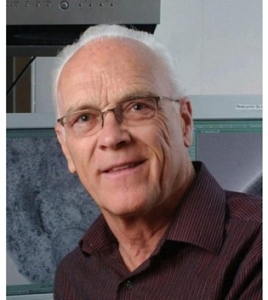
L. Andrew Staehelin
L. Andrew Staehelin died at the age of 83 on September 28, 2022. He was a professor in the Department of Molecular, Cellular and Developmental Biology (MCDB) at the University of Colorado Boulder.
Andrew was born in Sydney, Australia, on February 10, 1939. His family moved to Switzerland in 1948, where he grew up and attended the Gymnasium in Bern. To pursue his broad interests in natural sciences and biology, Andrew attended the Swiss Federal Institute of Technology. He completed his undergraduate studies between 1959 and 1963, and obtained his PhD in plant cell biology in 1966 under the supervision of Kurt Mühlethaler. He then moved to New Zealand where he worked at the Physics and Engineering Laboratory of the Department of Scientific and Industrial Research between 1966 and 1969. Deeply interested in pushing the boundaries of biological electron microscopy, Andrew moved to Boston in 1969 to pursue his postdoctoral training with Keith Porter at Harvard University.
In 1970 and at the age of 31, Andrew became an Assistant Professor in the newly formed Department of MCDB at the University of Colorado Boulder where he spent all his professional career. He was promoted to associate professor in 1973, then to full professor in 1978, and to professor emeritus in 2006. In addition, he held visiting professorship positions in several academic institutions such as Albert-Ludwigs University of Freiburg, the Swiss Federal Institute of Technology, and University of Melbourne. But Boulder and the surrounding mountains were Andrew’s home. He often came to the lab with exciting tales of a ski, hiking, or biking adventure that he had with his children and wife, Margrit, the previous weekend, and he often recounted that he had some new biological insights on a project while out in the wilderness.
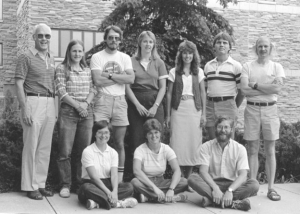
Staehelin Lab 1984
Andrew’s academic career revolved around two of his passions, teaching and discerning the structure of plant cells to better understand their function. He was an inspiring and devoted teacher, who enjoyed interacting with undergraduate students in the challenging settings of large introductory courses at CU Boulder. He was recognized with two teaching awards for his impact in undergraduate teaching. He had endless patience for undergraduate students in his classes, and he was very supportive and generous with his time and professional advice when they came to his office hours. Andrew’s passion for teaching was contagious, and it spread to everyone he trained, influencing their own careers and the scores of students they would eventually train at colleges and universities everywhere.
He trained and mentored many graduate students and postdoctoral researchers from all over the world in his laboratory. All those who were lucky to be part of his research group, learned cell biology and electron microscopy from a mentor whose rigorous attention to detail and perfectionism were only matched by his optimism, enthusiasm, good humor, generosity, and endless energy. There was always a smile on his face. He kept a magnifying glass in his desk drawer for inspecting the little details of electron micrographs. The poor student or post-doc would cringe when he reached for this magnifying glass. One never knew if the results would be a gentle scolding on astigmatismor a triumphant “AHA! Notice the clathrin coats on the trans-Golgi network!” In the years before digital cameras, he would examine draft figures, then send us back to the darkroom yet again to make subtle adjustments to the contrast and composition of the micrographs. Despite the momentary frustration of having to go back and start over and over again, we always had to agree with him that the final product was far better than what we originally had deemed sufficient.

Fondue at Andrew’s and Margrit’s home 1999
Andrew also had amazing people skills. He understood that a happy, cohesive lab group is a productive group. He fostered a team spirit through annual lab ski outings and the legendary holiday fondue party that Andrew and Margrit hosted at their home each year. People from both inside and outside the lab regularly turned to Andrew for wise advice on careers and personal challenges, often years after leaving Boulder.
Andrew understood early on in his career that the preservation of the biological material under study was crucial to uncover the function of cells and their organelles. He recognized the limitations of chemical fixation and devoted his efforts to develop and optimize cryofixation methods for plant material. In the early 70s and 80s, Andrew used rapid freezing and freeze fracture to address two major topics in plant biology, the organization of photosynthetic membranes and the site of cellulose synthesis. His lab provided decisive evidence in favor of the indirect coupling of electron transport to ATP synthesis by demonstrating that the ATP synthase enzyme (then known as the coupling factor) was confined to the stromal (unstacked) regions of the photosynthetic membrane (Miller and Staehelin, 1976). His work on spinach chloroplasts showed the relationship between stroma and grana thylakoids and the dynamic distribution of photosystem complexes (Staehelin, 1976). By applying rapid freezing and freeze-fracturing to plant cells and green algae, and by drawing on his previous research on cellulose deposition at the plasma membrane (Kiermayer and Staehelin, 1972), Andrew and his students were able to visualize plasma membrane-localized rosette complexes actively synthesizing cellulose (Giddings et al., 1980). The lab’s pioneering work not only showed the production of microfibrils from cellulose synthase complexes at the plasma membrane but made important predictions about the assembly of the cellulose synthase complexes in the endomembrane system and their mobility at the plasma membrane as an essential aspect of cellulose synthesis and deposition.
At atmospheric pressure, effective cryofixation (with no detectable ice crystal damage) can only be achieved within ~10 µm from the sample surface. To successfully preserve the interior of plant cells, Andrew optimized and introduced high-pressure freezing, rapidly cooling samples to cryogenic temperatures in a few milliseconds while applying high pressure (~2,000 atm) (Dahl and Staehelin, 1989). This is still the best available technique for the preservation of eukaryotic cells and tissues. Using high-pressure freezing and immunolabeling, Andrew’s group showed novel structural features of Golgi stacks (Staehelin et al., 1990), the response of Golgi stacks and vesicles to trafficking inhibitors and the compartmentalization of their glyco-enzymatic activities (Moore et al., 1991; Zhang and Stahlin, 1992; Zhang et al., 1993; Driouich et al., 1992). and vacuole biogenesis (Zheng and Staehelin, 2011). By applying high-pressure freezing to dividing plant cells, Andrew’s lab also revealed a series of previously uncharacterized intricate membranous intermediates that occur during the assembly of plant cell plates (Samuels et al., 1995) and a specialized form of cortical endoplasmic reticulum in gravity-sensing root tip columella cells (Zheng and Staehelin, 2001).
In the late 90s and the first decade of the 21st century, with the development of electron tomography and 3D modeling at CU Boulder, Andrew successfully introduced 3D tomographic reconstructions as a critical new tool in his research. Electron tomography allowed the Staehelin lab to further push Andrew’s passion for structure-function connections leading to a prolific time with breakthrough publications on preprophase band assembly (Karahara et al., 2009; Takeuchi et al., 2016), phragmoplast organization (Austin et al., 2005), cell plate formation (Otegui et al., 2001; Seguí-Simarro et al., 2004), Golgi structure and function (Otegui et al., 2006; Donohoe et al., 2007; Kang and Staehelin, 2008; Kang et al., 2011; Donohoe et al., 2013), and the architecture of thylakoid membranes in plant chloroplasts (Austin and Staehelin, 2011). 3D modeling of cell reconstructions based on serial sections allowed for the study of the cell cycle-dependent dynamics of membranous compartments (Seguí-Simarro and Staehelin, 2006; Seguí-Simarro et al., 2008).
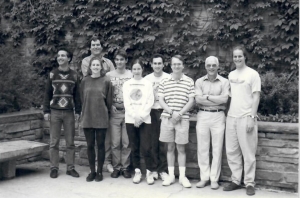
Staehelin Lab 1993
Andrew and his students and post-docs wrote almost 300 scientific papers and book chapters. He also edited several books with his always clear style and fabulous illustrations. The broad range of cell biology topics that he pushed forward through his career reflected his broad interest and endless curiosity for all aspects of cell biology. He had an outstanding knowledge of plant cell biology he shared with all of us. He was widely acknowledged as the “go-to” person for investigations of membrane dynamics in plant cells and had many collaborations with national and international colleagues. Significantly, he continued to publish through the year of his passing. Andrew was a master at interpreting plant cell structures through the lens of the latest advances in yeast and animal cell biology.
This sometimes meant that he would go out on a limb to propose some ideas that were controversial. His interpretations were creative, integrating new molecular genetics and biochemical insights. Andrew pushed the envelope, with thoughtfully constructed arguments, and challenged the field to do better.
In recognition to his scientific contributions, Andrew received several awards, including membership in the German National Academy of Sciences Leopoldina, fellow of the American Association for the Advancement of Science (AAAS), a faculty recognition award from CU Boulder, the Haselkorn Scholar Award from the University of Chicago, and fellow of the American Society of Plant Biologists.
His service to the research community included serving as editor of major journals and establishing the Plant Cell Wall Gordon Conference. After retirement, Andrew devoted efforts to educate the public about genetically modified crops and agricultural practices and wrote several op-ed articles for local newspapers. He was also a keynote speaker at the Plant Cell Dynamics Meeting in Madison, Wisconsin in 2017 and wrote several articles reviewing major challenges and breakthroughs in plant cell biology (Staehelin and Paolillo, 2020; Cheung et al., 2022).
Andrew is survived by his wife, Margrit, who has been his hiking and travel companion all around the world, as well as his sons and grandchildren.
He will be greatly missed as a beloved and inspirational mentor, colleague, and friend. His scientific and friendly spirit will live on.
References
Austin, J.R., 2nd, and Staehelin, L.A. (2011). Three- dimensional architecture of grana and stroma thylakoids of higher plants as determined by electron tomography. Plant Physiol 155, 1601-1611.
Austin, J.R., 2nd, Seguí-Simarro, J.M., and Staehelin, L.A. (2005). Quantitative analysis of changes in spatial distribution and plus-end geometry of microtubules involved in plant-cell cytokinesis. J Cell Sci 118, 3895-3903.
Cheung, A.Y., Cosgrove, D.J., Hara-Nishimura, I., Jürgens, G., Lloyd, C., Robinson, D.G., Staehelin, L.A., and Weijers, D. (2022). A rich and bountiful harvest: Key discoveries in plant cell biology. Plant Cell 34, 53-71.
Dahl, R., and Staehelin, L.A. (1989). High-pressure freezing for the preservation of biological structure: Theory and practice. J Elec Microsc Tech 13, 165-174.
Donohoe, B.S., Kang, B.H., and Staehelin, L.A. (2007). Identification and characterization of COPIa- and COPIb- type vesicle classes associated with plant and algal Golgi. Proc Natl Acad Sci U S A 104, 163-168.
Donohoe, B.S., Kang, B.H., Gerl, M.J., Gergely, Z.R., McMichael, C.M., Bednarek, S.Y., and Staehelin, L.A. (2013). Cis-Golgi cisternal assembly and biosynthetic activation occur sequentially in plants and algae. Traffic 14, 551-567.
Driouich, A., Zhang G.F., and Staehelin, L.A. (1993).Effect of Brefeldin A on the structure of the Golgi apparatus and on the synthesis and secretion of proteins and polysaccharides in sycamore maple suspension- cultured cells. Plant Physiol. 101, 1363-1373
Giddings, T.H., Jr., Brower, D.L., and Staehelin, L.A. (1980). Visualization of particle complexes in the plasma membrane of Micrasterias denticulata associatedwith the formation of cellulose fibrils in primary and secondary cell walls. J Cell Biol 84, 327-339.
Kang, B.H., and Staehelin, L.A. (2008). ER-to-Golgi transport by COPII vesicles in Arabidopsis involves a ribosome-excluding scaffold that is transferred with the vesicles to the Golgi matrix. Protoplasma 234, 51-64.
Kang, B.H., Nielsen, E., Preuss, M.L., Mastronarde, D., and Staehelin, L.A. (2011). Electron tomography of RabA4b- and PI-4Kβ1-labeled trans Golgi network compartments in Arabidopsis. Traffic 12, 313-329.
Karahara, I., Suda, J., Tahara, H., Yokota, E., Shimmen, T., Misaki, K., Yonemura, S., Staehelin, L.A., and Mineyuki,
Y. (2009). The preprophase band is a localized center of clathrin-mediated endocytosis in late prophase cells of the onion cotyledon epidermis. Plant J 57, 819-831.
Kiermayer, O. and Staehelin, L.A. (1972). Feinstruktur von Zellwand und Plasmamembran bei Micrasterias denticulata Breb. nach Gafrieratzung. Protoplasma 74,
227-237.
Miller, K. R., and Staehelin, L. A. (1976). Analysis of the thylakoid outer surface. Coupling factor is limited to unstacked membrane regions. J Cell Biol 68, 30-47.
Moore, P.J., Swords, K.M., Lynch, M.A., and Staehelin, L.A. (1991). Spatial organization of the assembly pathways of glycoproteins and complex polysaccharides in the Golgi apparatus of plants. J Cell Biol 112, 589-602.
Otegui, M.S., Mastronarde, D.N., Kang, B.H., Bednarek, S.Y., and Staehelin, L.A. (2001). Three-dimensional analysis of syncytial-type cell plates during endosperm cellularization visualized by high resolution electron tomography. Plant Cell 13, 2033-2051.
Otegui, M.S., Herder, R., Schulze, J., Jung, R., and Staehelin, L.A. (2006). The proteolytic processing of seed storage proteins in Arabidopsis embryo cells starts in the multivesicular bodies. Plant Cell 18, 2567-2581.
Samuels, A.L., Giddings, T.H., Jr., and Staehelin, L.A. (1995). Cytokinesis in tobacco BY-2 and root tip cells: a new model of cell plate formation in higher plants. J Cell Biol 130, 1345-1357.
Seguí-Simarro, J.M., Austin, J.R., 2nd, White, E.A., and Staehelin, L.A. (2004). Electron tomographic analysis of somatic cell plate formation in meristematic cells of Arabidopsis preserved by high-pressure freezing. Plant Cell 16, 836-856.
Seguí-Simarro JM, Staehelin LA. (2006). Cell cycle- dependent changes in Golgi stacks, vacuoles, clathrin- coated vesicles and multivesicular bodies in meristematic cells of Arabidopsis thaliana: a quantitative and spatial analysis. Planta 223, 223-236.
Seguí-Simarro JM, Coronado MJ, Staehelin LA. (2008). The mitochondrial cycle of Arabidopsis shoot apical meristem and leaf primordium meristematic cells is defined by a perinuclear tentaculate/cage-like mitochondrion. Plant Physiol 148, 1380-1393.
Staehelin, L.A. (1976). Reversible particle movements associated with unstacking and restacking of chloroplast membranes in vitro. J Cell Biol 71, 136-158.
Staehelin, L.A., and Paolillo, D.J. (2020). A brief history of how microscopic studies led to the elucidation of the 3D architecture and macromolecular organization of higher plant thylakoids. Photosynth Res 145, 237-258.
Staehelin, L.A., Giddings, T.H., Jr., Kiss, J.Z., and Sack, F.D. (1990). Macromolecular differentiation of Golgi stacks in root tips of Arabidopsis and Nicotiana seedlings as visualized in high pressure frozen and freeze-substituted samples. Protoplasma 157, 75-91.
Takeuchi, M., Karahara, I., Kajimura, N., Takaoka, A., Murata, K., Misaki, K., Yonemura, S., Staehelin, L.A. and Mineyuki, Y. (2016). Single microfilaments mediate the early steps of microtubule bundling during preprophase band formation in onion cotyledon epidermal cells. Molecular biology of the cell, 27, 1809-1820.
Zhang, G.F., Driouich, A., and Staehelin, L.A. (1993). Effect of monensin on plant Golgi: reexamination of the monensin-induced changes in cisternal architecture and functional activities of the Golgi apparatus of sycamore suspension-cultured cells. J. Cell Sci 104, 819-831.
Zhang, G.F., and Staehelin, L.A. (1992). Functional compartmentalization of the Golgi apparatus of plant cells. An immunochemical analysis of high pressure frozen and freeze substituted sycamore maple suspension-cultured cells. Plant Physiol 99, 1070-1083.
Zheng, H. and Staehelin, L.A. (2001). Nodal endoplasmic reticulum, a specialized form of endoplasmic reticulum found in gravity-sensing root tip columella cells. Plant Physiol 125, 252-265.
Zheng, H. and Staehelin, L.A. (2011). Protein storage vacuoles are transformed into lytic vacuoles in root meristematic cells of germinating seedlings by multiple, cell type-specific mechanisms. Plant Physiol 155, 2023-2035.
Remembering Eldon Henry Newcomb

Remembering Eldon Henry Newcomb
BY KATE VANDENBOSCH AND DONNA FERNANDEZ
Eldon Henry Newcomb, Folke Skoog Emeritus Professor of Botany at the University of Wisconsin-Madison, died April 26, 2022 in Madison at the age of 103. A distinguished scientist and dedicated educator, he spent more than four decades at the University of Wisconsin before retiring in 1990. Eldon is best remembered for his exemplary applications of electron microscopy to plant cell biology. In recognition of his achievements, he was elected to the National Academy of Sciences in 1988.
Eldon was born on January 19, 1919 in Columbia, Missouri. He felt an urge to explore the unknowns of the natural world from an early age. His parents encouraged his natural history pursuits and he began to collect insects by age 11. By 17, he was nature lore director at a Boy Scouts camp in the Ozarks, a post that he kept for many years.
Eldon completed both his bachelor’s and master’s degrees in botany at the University of Missouri in Columbia. With his wide ranging interests in plants, insects and microbes, it is not surprising that he explored organismal interactions in early research. His master’s thesis focused on wood-burrowing ambrosia beetles that cultivate fungi to feed their larvae. He also developed an interest in the metabolism of oak leaf galls caused by cynipid wasps.
Eldon’s education was interrupted by World War II, but not his scientific endeavors. The Army assigned him to a malaria unit that carried out mosquito surveys and control in North Africa and the Middle East. In their off hours, Eldon and other team members collected insects that were shared with entomologists in the United States and the United Kingdom and resulted in two published works.
After the war, Eldon enrolled at the University of Wisconsin-Madison for his PhD. Inspired by contemporary advances in dynamic biochemistry, he hoped to use metabolic analysis to learn how gall-forming insects altered plant morphogenesis. Ultimately, he adopted the single-celled alga Chlorella pyrenoidosa as a simpler system for studying respiratory processes. After completing his PhD in 1949, Eldon was appointed to the faculty of botany at UW- Madison. Together with Folke Skoog, the noted plant growth regulator researcher, Eldon and colleagues advanced plant physiology as a strength within the Botany Department.
As an assistant professor, Eldon was interested in how auxin treatment effected cell growth. Initially, he continued studies of cellular metabolism, but these methods were unable to address what the cell wall-plasma membrane interface looked like or how the peripheral cytoplasm controlled cellulose deposition outside the cell. An appropriate imaging method was needed.
By the late 1950s, electron microscopy (EM) was established for high-resolution imaging, but its application for biological studies was hampered by technical limitations. Eldon and his students were among the first to apply a new fixative, glutaraldehyde, which allowed the preservation of many ultrastructural features, including microtubules. Their finding in the early 1960s that cortical microtubules oriented in parallel to the deposition of cellulose microfibrils happened simultaneously with the same finding by Keith Porter and Myron Ledbetter at Harvard, although the Harvard team published first. The further work by the Newcomb lab on the association of microtubules with developing cell walls influenced the development of the field of cytoskeletal function in cell wall development.
Plant peroxisomes became another major focus. In the late 1960s, Eldon and associates used EM in tandem with cytochemistry to show that certain single membrane-bound organelles have the diagnostic features of peroxisomes, which were unknown in plants at the time. The Newcomb lab identified plant peroxisomes that participated in photorespiration in leaves, fat metabolism in cotyledons and ureide metabolism in nitrogen- fixing soybean nodules. Their discovery that the ureide synthesis step in nitrogen assimilation occurs in uninfected cells in nodules led them to address more topics in rhizobial symbioses.
Over several decades, Eldon and associates applied electron microscopy to many additional aspects of plant cell structure and function. The lab advanced the understanding of coated vesicles, plastids and phloem ultrastructure, among other topics. Two research leaves in Australia detailed the structure and function of prokaryotic photosynthetic symbionts in sea squirts and leaf ultrastructure of marine seagrasses.
Eldon’s lab was widely recognized for the superb quality of their micrographs. When queried about the image quality that was the signature of the lab, Eldon said that there were no secrets; rather, it was a matter of fastidious attention to every detail in a long series of steps of specimen preparation, microscope operation and photography. In addition to their scientific merit, the published micrographs have an aesthetic quality due to their clarity, balance and framing. They set a standard for what could be achieved in electron microscopy. As a result, micrographs from the Newcomb lab have been reproduced as illustrations in numerous textbooks and reviews.
In addition to membership in the National Academy of Science, Eldon’s contributions were recognized through many awards. He held Guggenheim and Fulbright Fellowships, and was both awarded an honorary doctorate by the University of Missouri and elected to the Academy of Arts and Sciences in 1993. The University of Wisconsin-Madison awarded him a named professorship in 1987 and the Newcomb Imaging Center was named after him in the Department of Botany in 2014.
Throughout his faculty career, Eldon was a devoted and enthusiastic teacher. He was passionate about incorporating new findings in biochemistry and genetics into general botany courses, and he initiated advanced courses in plant metabolism and plant cell biology. In collaboration with others, Eldon developed summer programs for high school biology teachers and a new introductory course series for biology majors that was based on shared concepts among diverse organisms. When student interest in ecology and diversity surged after the first Earth Day, he even stepped up to help teach plant taxonomy and dendrology.
Eldon’s enthusiasm about the biological sciences went beyond the discoveries to include the people who made them. He was a terrific storyteller and, when reflecting on his career, was quick to recognize the important people and opportunities that influenced him. In his mentoring, he was mindful of creating such opportunities for others. He was fortunate to enjoy a long, dynamic career and he leaves a vibrant legacy from his long life.
Remembering Sorina Popescu
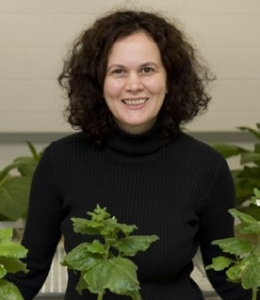
Remembering Sorina Popescu
BY GREG BOHACH
Sorina Popescu was born on March 4, 1969, in Brasov, Romania to Elisabeta and Lazar Cristea. She was a student athlete and excelled in school from an early age, working as a pharmacist before moving to the capital city of Bucharest for university studies. She earned her MS degree in biology at the University of Bucharest, where she later joined the Faculty in the Plant Biology Department. She started her PhD work there, studying oomycetes unique to the Danube Delta, and continued in the US. While in college, she met her husband, George Popescu, a physics, and engineering student. Together, they weathered the Romanian Revolution of 1989 and the chaos of post-Communist Romania, participating in meetings and marches for liberty and a free society. Their daughter Medeea was born in 1995, and shortly afterward the family emigrated to the United States. Sorina attended graduate school at Rutgers University supported by several fellowships and grants and earned her PhD in plant molecular biology in 2003. She excelled in graduate school despite the demands of raising a child, learning a new language, and adjusting to life in a very different country.
The family next moved to Connecticut when Sorina started a postdoctoral position at Yale University, where she led a flagship NSF program on plant protein microarrays. At Yale, Sorina and George began a scientific collaboration that would last until her death, combining their respective skills into a program of rigorous, innovative, and creative research. She published widely cited studies on calcium signaling and MAPK signaling networks in plants using her protein microarray chips. Their son, Nicholas, was born during this time in 2005.
In the Fall of 2008 Sorina was appointed to a faculty position at the Boyce Thompson Institute for Plant Science, and the family moved to Ithaca, New York, for several years. While in Ithaca, Sorina and her family enjoyed hiking and cross-country skiing together. She advised four postdocs and two graduate students, all of whom went on to successful research careers. While at BTI, she co-led two NSF projects on plant signaling networks and plant disease resistance, while expanding her plant proteomics research focus. She discovered that thimet oligopetidases are salicylic acid-binding modulators of plant immune responses, identified new pathways associated with tomato resistance to Pseudomonas syringae, and investigated the role of integrin-like kinases in plant stress.
After seven years at Cornell, Sorina moved to Mississippi State University, where she further developed her research and teaching. She mentored eight graduate students and advised many undergraduate and graduate students. One of her passions was to provide opportunities for women to advance in science. She was a great teacher. She taught General Biochemistry and created a graduate Cellular Signaling course and an online Plant Biochemistry and Molecular Biology course. At MSU, she led two nationally competitive NSF projects in plant proteomics and redox signaling and started new research directions in plant-pathogen interaction and microbial communities. This work eventually led to applied research sponsored by the MS Soybean Promotion Board. She was a frequent NSF and USDA panelist, grant reviewer for national and international agencies, editor for Molecular and Cellular Proteomics, MPMI, and Current Plant Biology, while serving as a reviewer for numerous other journals. Finally, she was an invited speaker and organizer of dozens of plant research conferences and workshops.
Despite a three-year struggle with breast cancer and many rounds of radiation, chemotherapy, and immunotherapy, Sorina never gave up on herself, her ability to heal, or her ability to meaningfully contribute to the field of plant biology. She continued to run her lab, teach classes and mentor her students until her last days. She was passionate about her work and touched the lives of so many people.
Outside of the lab, Sorina loved walking and biking at the Noxubee Wildlife Refuge, watching Nick’s soccer games and tennis matches, spending holidays on the Gulf Coast at the beach, and spending time in the kitchen of the family’s peaceful rural home. She loved her family dearly and traveled back to Romania frequently to be with her parents, sister, and extended family. She was lucky enough to visit Romania one last time, attend her daughter’s wedding, and learn of her son’s acceptance to Duke while battling the disease. Sorina died on December 19, 2022, of metastatic breast cancer. She was 53. Her final resting place is the Holy Trinity Church in Schei, Brasov, Romania. She is survived by her sister, Luminita Cristea; her mother, Elizabeta Cristea; her son and daughter, Nicholas and Medeea Popescu; and her husband, George.
________________________
Memorial donations may be made to the Dr. Sorina Popescu Memorial Annual Scholarship in the College of Agriculture and Life Sciences, MSU Foundation, P.O. Box 6149, Mississippi State, MS 39762. To make an online gift please visit www.msufoundation.com and designate the Dr. Sorina Popescu Memorial Annual Scholarship (#403663).
________________________
Journal News
Journal News
Editor-in-Chief Search is Under Way
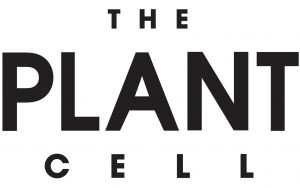 As The Plant Cell Editor-in-Chief Blake Meyers’ successful term comes to an end, ASPB has embarked on the search for a new Editor-in-Chief for the journal. The Society received more than 20 nominations, and the Editor Search Committee—comprising the ASPB Publications Committee, Past-President Gustavo MacIntosh, and ASPB CEO Crispin Taylor—is inviting vision statements from nominees. The incoming Editor-in-Chief will be appointed in early 2024 and work closely with Blake in his final year as Editor-in-Chief before Blake’s term officially ends in December 2024.
As The Plant Cell Editor-in-Chief Blake Meyers’ successful term comes to an end, ASPB has embarked on the search for a new Editor-in-Chief for the journal. The Society received more than 20 nominations, and the Editor Search Committee—comprising the ASPB Publications Committee, Past-President Gustavo MacIntosh, and ASPB CEO Crispin Taylor—is inviting vision statements from nominees. The incoming Editor-in-Chief will be appointed in early 2024 and work closely with Blake in his final year as Editor-in-Chief before Blake’s term officially ends in December 2024.
Author Profiles Get an Update
First author profiles have long been a popular feature for Plant Physiology, The Plant Cell, and Plant Direct authors to be spotlighted in their community. These profiles previously included a long-form biography- style blog post, image, and accompanying social media post, all shared around the time an author’s paper published. Gathering and tracking all of these components proved to be a significant task, though data showed that it was worthwhile: articles that feature an author profile average an altmetric score more than three times higher than articles without an author profile. Looking deeper at the data, readers interacted with the social media post most often but rarely clicked through to read the long-form blog post. To maintain this valuable service for authors and eliminate the challenges of gathering and coordinating long-form content, author profiles recently underwent an update to be more social-focused. Authors are spotlighted on an eye-catching graphic that’s shared via journal social media with a direct link to the author’s article, and each week a collection of author highlights are posted on Plantae and shared in the “ASPB Signal” newsletter. In addition to saving time for authors and ASPB staff, this new format drives more traffic directly to journal articles and maintains the higher altmetric score trends on featured articles.
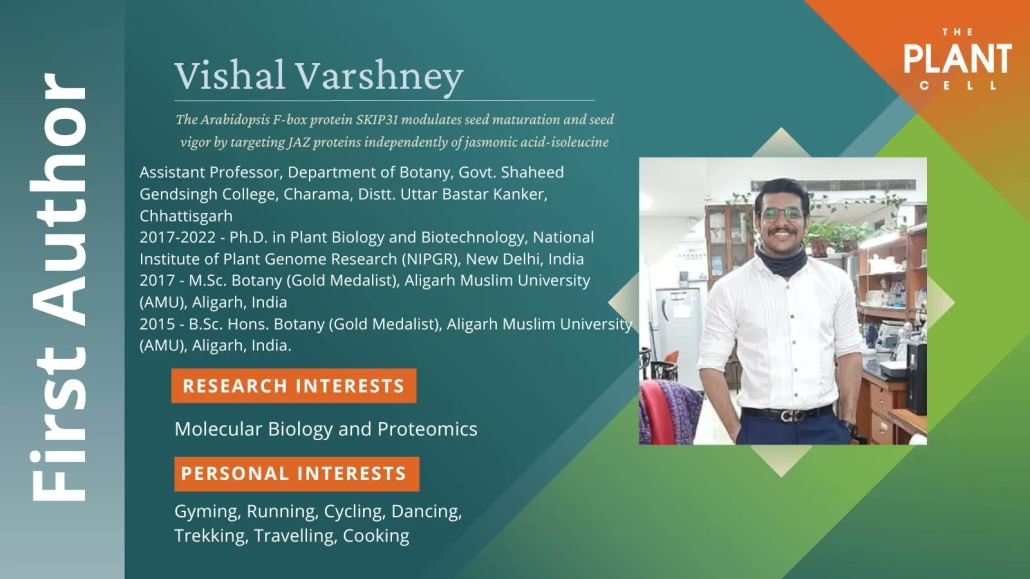
The new format of the author profile images shared on social media
The Plant Cell Editorial Board Convened in Savannah
On Saturday, August 5, 2023, members of The Plant Cell’s Editorial Board, together with representatives from Oxford University press and ASPB staff, met ahead of Plant Biology 2023 in Savannah, Georgia, to review the journal’s performance, strategic priorities, and future. Editor-in- Chief Blake Meyers presided over the meeting, which included breakout discussions exploring topics such as Editorial Board leadership through the peer review process; increasing diversity, equity, and inclusion on the Editorial Board; and exploring potential new content types not currently being published by the journal. Takeaways from those breakout group discussions will be addressed as the journal team evaluates and sets its strategic plan for the coming year.
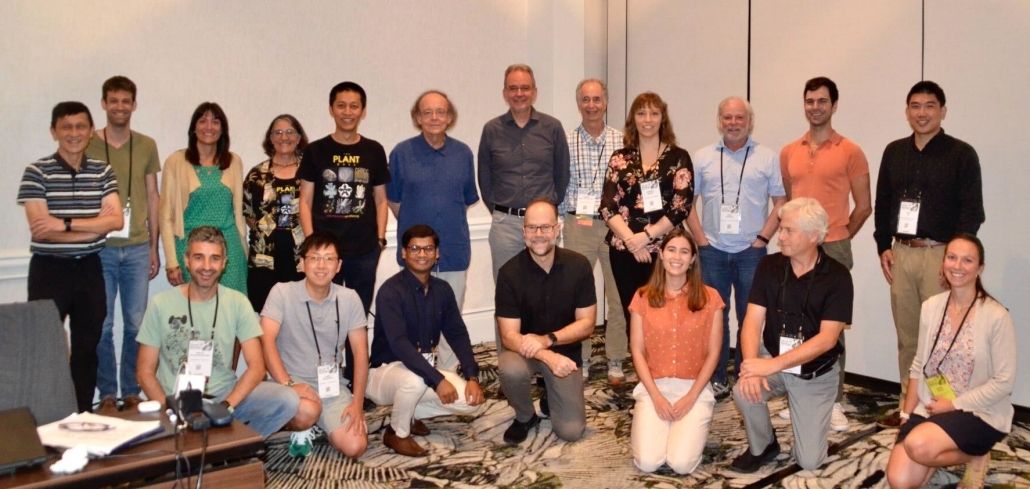
Plant Physiology and The Plant Cell Adopt an AI Policy
As AI-driven tools like ChatGPT are increasingly adopted by authors, ASPB’s Plant Physiology and The Plant Cell have formally adopted a policy as of August 17, 2023, available on both of the journals’ websites in the instructions to authors. The policy aligns with guidance from the Committee on Publication Ethics and states:
Natural language processing tools driven by artificial intelligence (AI) do not qualify as authors, and the Journal will screen for them in author lists. The use of AI (for example, to help generate content, write code, or process data) should be disclosed both in cover letters to editors and in the Methods or Acknowledgements section of manuscripts. Please see the COPE position statement on AI and authorship for more details.
Transparent Peer Review Comes to Plant Physiology
 While authors have been able to opt in to publishing peer review reports with papers published in The Plant Cell, the manual nature of generating the reports proved to be a challenge in implementing this measure for Plant Physiology papers. However, transparent peer review has been an important goal of Editor-in-Chief Yunde Zhao, and after nearly a year working behind the scenes with technology providers to be able to accurately generate these reports at scale, Plant Physiology authors will now have the ability to opt in to publishing a peer review report with their published paper. Authors may indicate their interest in publishing a peer review report at the time of submission; prior to publication, authors will have the opportunity to review the report
While authors have been able to opt in to publishing peer review reports with papers published in The Plant Cell, the manual nature of generating the reports proved to be a challenge in implementing this measure for Plant Physiology papers. However, transparent peer review has been an important goal of Editor-in-Chief Yunde Zhao, and after nearly a year working behind the scenes with technology providers to be able to accurately generate these reports at scale, Plant Physiology authors will now have the ability to opt in to publishing a peer review report with their published paper. Authors may indicate their interest in publishing a peer review report at the time of submission; prior to publication, authors will have the opportunity to review the report
and approve it. Author approval of the report is critical; if an author ultimately decides not to move forward with publishing the report, the peer review report is not published with the article. Peer review reports will be published with supplemental materials.
The Plant Cell and Plant Physiology Webinar Libraries Now Online
For those who enjoy the added discussion following Focus Issues of The Plant Cell and Plant Physiology, you can now find the entire library of recorded webinars linked on the journals’ webpages along with links to upcoming webinars.
Call for Papers
Submit to an Upcoming Focus Issue
| Plant Physiology | ||
| Focus Issue Title | Submission Deadline | Publication Date |
| 2024 Focus Issue on Root Development | Jan, 1, 2024 | Sept. 2024 |
| 2024 Focus Issue on Plant Lipids: Signaling and Metabolism | Mar. 31, 2024 | Nov. 2024 |
| 2024 Focus Issue on ‘Hypoxia and Plants’ | June 2024 | Jan. 2025 |
| The Plant Cell | ||
| 2024 Focus Issue on Proteolysis | Oct. 1, 2023 | Aug. 2024 |
| 2024 Focus Issue on Photosynthesis | Nov. 1, 2023 | June 2024 |
Happening on Plantae

Happening on Plantae
Plantae Webinar Series
In a new series of webinars, members of the Plantae Fellows program and select contributors will gather to discuss various important plant science–related topics that are relevant today. Take advantage of the opportunity to engage with Plantae’s global plant science community. Stay updated at https://plantae.org/education/plantae-webinars.
 Plant Science Research Weekly
Plant Science Research Weekly
Plantae editors highlight new plant science research articles with short summaries that describe key findings and links to the full articles. Get this exciting roundup of plant science research delivered right to your inbox. Subscribe at https://plantae.org/research/wwrtw/.
 Tell us what you think!
Tell us what you think!
The ASPB News strives to meet members’ needs and interests. To ensure the publication continues to evolve along with ASPB members, please take just a few minutes to answer five questions about the ASPB News. We’ll use the information to help shape future issues and the overall publication going forward.
Take the survey: https://qrco.de/bdFEHu
